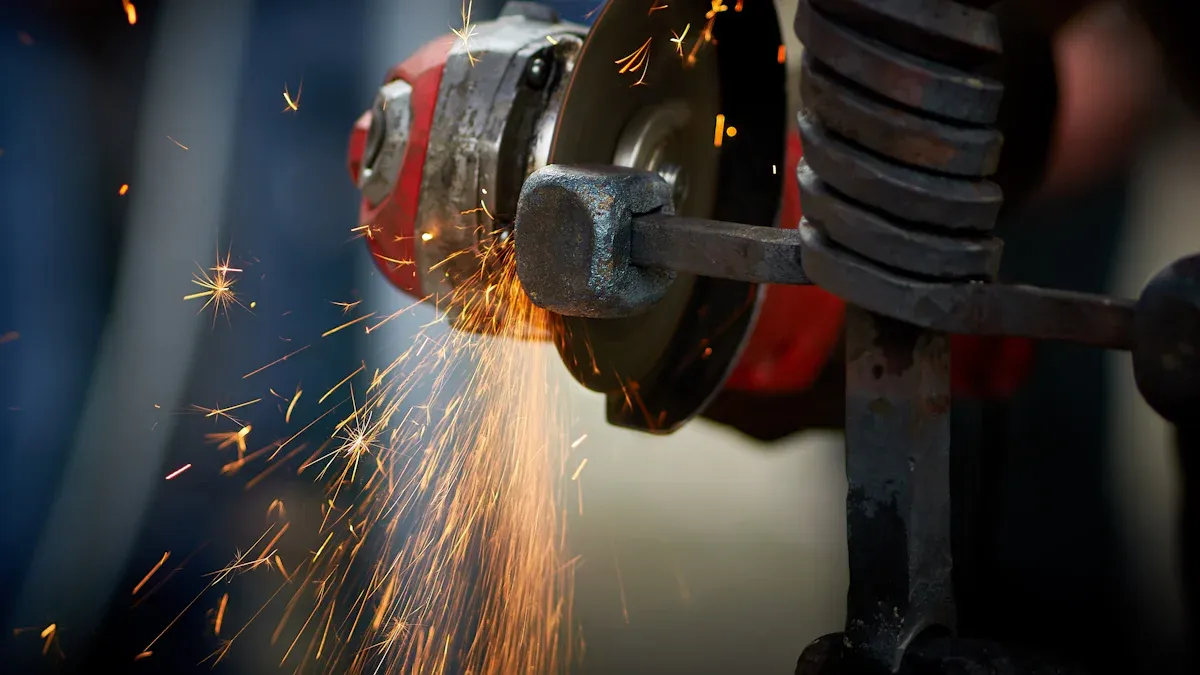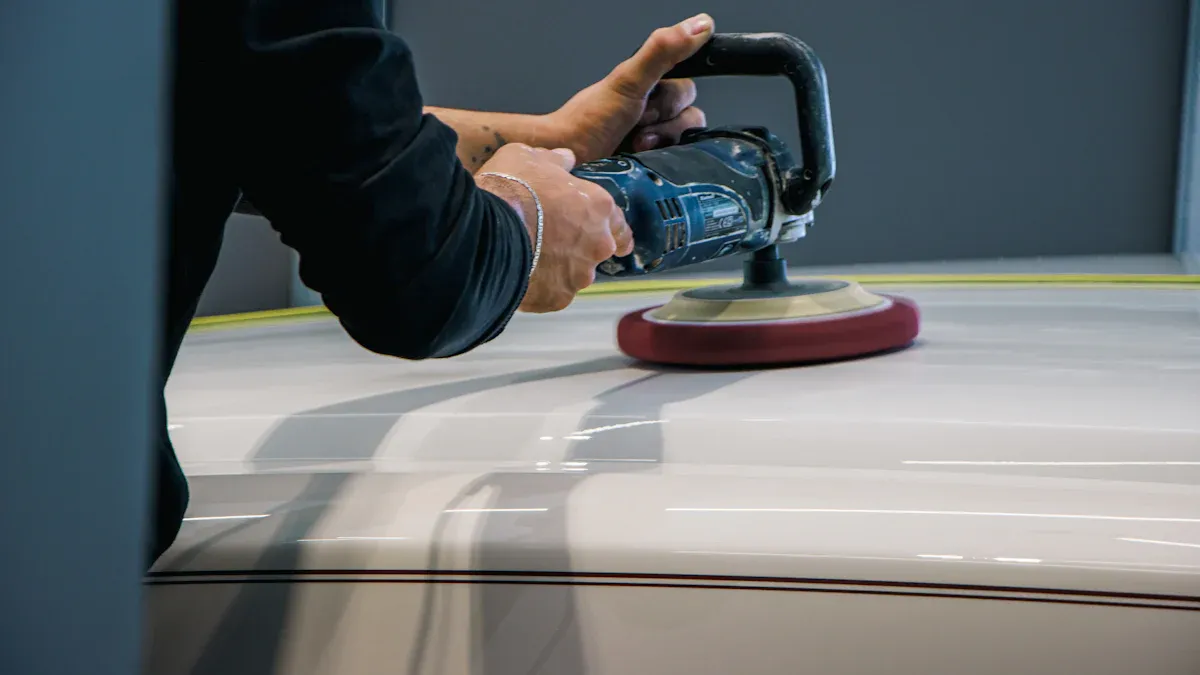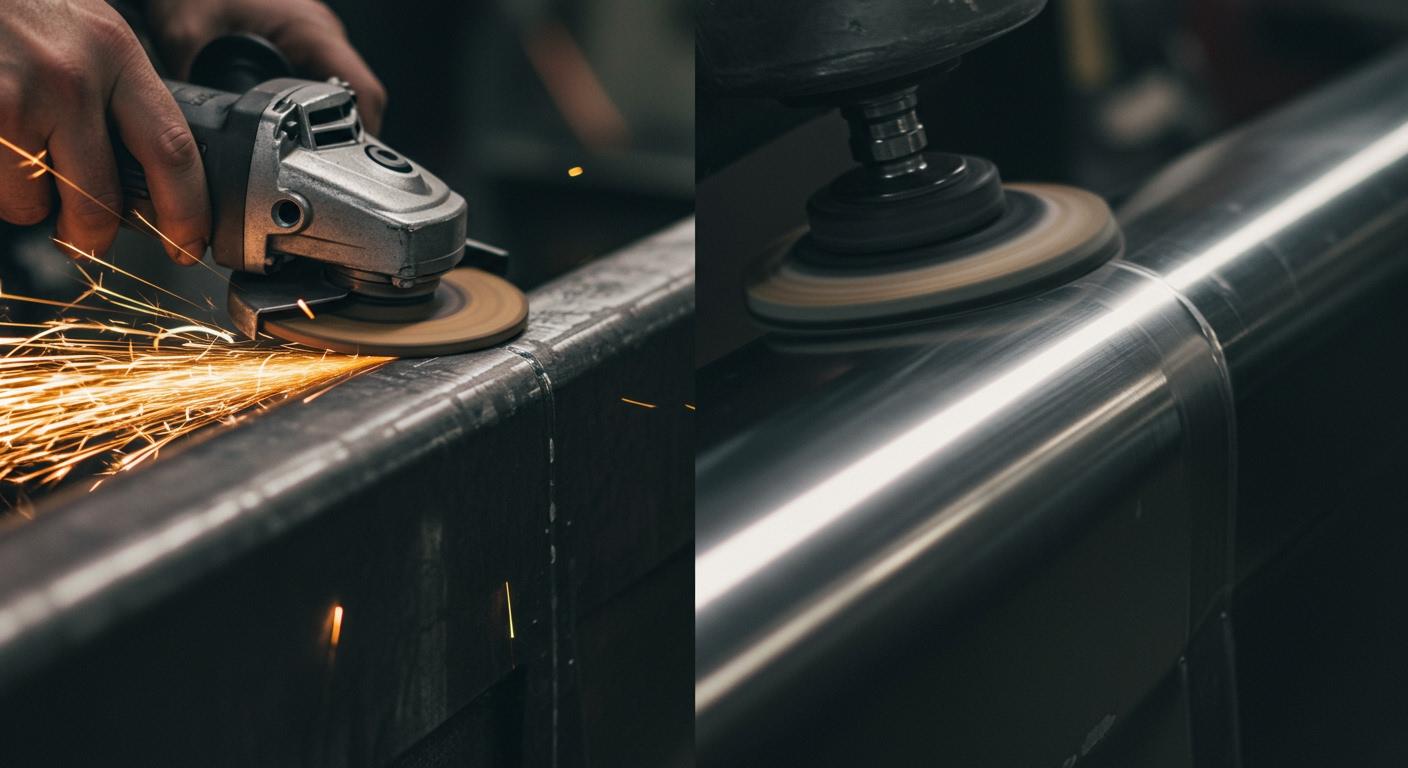Think about the difference between grinding and polishing this way. Grinding is like using coarse sandpaper to shape rough wood. Polishing is like using a soft cloth to make a car shine. Grinding is an aggressive step to remove material. The global abrasives market is projected to reach USD 52.59 billion by 2030, highlighting the value of these skills. The key differences between grinding and polishing show they are separate stages. Polishing as a surface refinement process uses a polishing wheel to create a smooth surface, which is very different from grinding.
Key Takeaways
- Grinding removes a lot of material quickly. It changes the shape or size of an object. This makes the surface dull but even.
- Polishing makes a surface smooth and shiny. It removes tiny scratches left by grinding. This creates a mirror-like finish.
- Grinding uses rough tools to cut and shape. Polishing uses soft tools and very fine materials to smooth. They have different goals.
- Always grind first if a surface has big flaws. Grinding prepares the surface. Then, polish to make it look great.
What is grinding? The abrasive shaping process

Grinding is the powerful first step in surface finishing. You use this process when you need to remove a significant amount of material quickly. Think of it as the heavy-lifting phase that prepares a workpiece for finer finishing touches.
Purpose: Material removal and shaping
The main goal of grinding is to change an object’s shape or size. You might use it to flatten a surface, sharpen a tool, or remove deep flaws like welds and scratches. This process is fundamental across many industries for creating precise components. Key applications include:
- Aerospace: Producing high-precision parts like turbine blades and landing gear.
- Automotive: Shaping engine parts such as crankshafts and camshafts.
- Medical: Creating surgical instruments and orthopedic implants with exact dimensions.
- Tool and Die: Sharpening cutting tools and dies for manufacturing.
Process: Creating controlled scratches
Grinding works by using an abrasive wheel to create a pattern of controlled scratches on a surface. These scratches remove material efficiently. The speed of material removal can be quite impressive, depending on the specific grinding method you use.
| Grinding Process | Typical Material Removal Rate |
|---|---|
| Surface Grinding | 1 in³ per second |
| Cylindrical Grinding | 1 in³ per second |
| Superabrasive Machining | 1 in³ every 10-15 seconds |
| Tool and Cutter Grinding | 1 in³ every 20-30 seconds |
For tough materials like ceramics, composites, or hard alloys, you need specialized tools. Expert brands offer solutions like diamond grinding wheels from Aimgrind that provide the necessary precision and durability for demanding jobs like metal grinding. The abrasive grit on the wheel determines the depth of the scratches.
Result: A uniform but dull surface
After the grinding process, the surface will have a uniform, matte, or dull appearance. While the major imperfections are gone and the piece has the correct shape, it is covered in fine scratches. This non-reflective finish is the intended outcome of grinding. It creates the perfect, consistent foundation required before you can even think about achieving a mirror-like shine through polishing.
Polishing as a surface refinement process

After grinding shapes the workpiece, you can begin polishing as a surface refinement process. This is the delicate final stage where you transform a dull, uniform surface into a brilliant, smooth one. Polishing is not about removing large amounts of material; it is about creating aesthetic appeal and functional smoothness.
Purpose: Creating smoothness and shine
The primary goal of polishing is to create a smooth, highly reflective surface. This process enhances a product’s appearance, making it look professional and high-quality. Many industries depend on a flawless finish for both looks and function. Key sectors include:
- Automotive Industry
- Watch and Jewellery
- Electronic Devices
- Musical Instruments
- Sanitary Fittings
- Household Goods
Process: Using progressively finer abrasives
Polishing works by smoothing out the microscopic scratches left by grinding. You achieve this by using a series of progressively finer abrasives. You start with a coarser compound to remove the initial grinding marks. Then, you switch to finer compounds in successive steps. Each step removes the scratches from the previous one, leading to an increasingly smooth surface. This careful progression is the secret to effective polishing.
Tools: The polishing wheel and compounds
Your main tools for this job are a polishing wheel and various polishing compounds. The polishing wheel, often made of cloth or felt, carries the abrasive compound to the workpiece. Choosing the right compound is crucial for tasks like metal polishing. Different compounds are designed for specific materials and stages of the polishing process.
| Compound Type | Main Use | Best For Materials |
|---|---|---|
| Brown Tripoli | Cutting and smoothing | Softer metals (copper, brass, aluminum) |
| White | Cutting rough surfaces | Hard metals, Stainless steel |
| Green | Finishing with a mirror-like shine | Stainless steel |
| Blue | Restoring original smoothness | Plastics, Non-ferrous metals |
| Black | Cutting and finishing | Steel, Copper, Brass, Aluminum |
Result: A smooth and reflective finish
The final result of proper polishing is a flawless, mirror-like finish. The surface becomes so smooth that it reflects light with minimal distortion. In technical terms, a true mirror finish has a surface roughness (Ra) value between 0.02 and 0.08 micrometers. This ultra-smooth surface is achieved when the polishing wheel and the right compound have removed all visible imperfections, leaving behind only pure shine.
Key differences between grinding and polishing
Understanding the core differences between grinding and polishing is crucial for achieving a professional finish. While both processes use abrasives, their goals, methods, and results are completely distinct. Let’s break down what sets them apart.
Goal: Shaping vs. shining
Your primary goal with grinding is to change the physical shape of a workpiece. Grinding is an abrasive machining process you use to remove excess material, achieve precise dimensions, and fix major surface imperfections. It is all about function and form. You use this process to ensure a part meets exact specifications.
Polishing, on the other hand, focuses entirely on aesthetics and smoothness. It does not improve a workpiece’s dimensional accuracy.
When you are polishing, your objective is to create a visually captivating surface. This process:
- Enhances Visual Appeal: Polishing brings out the natural beauty and color of a material.
- Creates Reflective Surfaces: It produces a mirror-like finish that makes objects look vibrant and luxurious.
Abrasives: Coarse vs. fine
The abrasives used for grinding are much harder and coarser than those used for polishing. Grinding requires aggressive materials to cut and shape hard surfaces. For example, aluminum oxide, a common abrasive in grinding wheels, has a Mohs hardness of 9.
In contrast, polishing uses much finer and softer abrasive particles. These particles gently smooth the surface instead of cutting it. You can see the hardness difference clearly.
| Material | Mohs Hardness | Primary Use |
|---|---|---|
| Brown Fused Aluminum Oxide | ~9 | Grinding |
| Cerium Oxide | 6 – 7 | Polishing |
Abrasive coarseness is measured by grit size. In the American (CAMI) system, grit sizes are identified by a number. A low number like 24 indicates a very coarse grit for aggressive grinding, while numbers up to 1200 represent super fine grits used in the final stages of finishing.
Surface impact: Creating vs. removing scratches
One of the most important distinctions is how each process affects the surface at a microscopic level. Grinding fundamentally works by creating scratches.
- Grinding (Cutting mode): Involves the shearing of workpiece material by abrasive grains.
This cutting action is what removes material. A microscopic view of a ground surface reveals a rough, distorted texture. This makes it difficult to see fine details or take accurate measurements.
- Smooth, flat, and free from physical distortions.
- Clear enough for high-resolution imaging and precise analysis.
Final appearance: Matte vs. mirror-like
The final look is one of the most obvious differences between grinding and polishing. After grinding, you are left with a uniform but dull, non-reflective surface. This matte finish has a very low light reflectivity. On a gloss meter, it would measure less than 10 Gloss Units (GU).
| Finish Type | 60° GU Measurement |
|---|---|
| Matte | Less than 10 GU |
| Mirror-like | Up to 2,000 GU (at 20°) |
Polishing transforms that matte surface into a brilliant, mirror-like finish. A fully polished surface can reflect almost 100% of light, similar to a piece of marble. This high Light Reflectance Value (LRV) not only looks great but can also brighten a room by distributing light more effectively. The result of proper polishing is a flawless shine that is both beautiful and functional.
Practical applications and when to use each
Knowing when to use grinding versus polishing is key to getting the job done right. Each process has specific jobs where it excels. You choose the process based on your starting point and your final goal.
Common scenarios for grinding
You should turn to grinding for heavy-duty tasks that require significant material removal or shaping. This process is all about making big changes to a surface. Common jobs for grinding include:
- Leveling concrete floors to create a flat, even base.
- Removing excess metal from welds, like on large industrial pipes used for oil and gas.
- Shaping rough stone into finished countertops.
Safety First! ⚠️
Grinding is a powerful process. You must always follow safety standards, such as using proper wheel guards and wearing personal protective equipment (PPE) like safety goggles. Regulations like those from OSHA require these precautions to prevent injury.
Common scenarios for polishing
You use polishing when your goal is to create a smooth, reflective finish. This is the final step that brings out the beauty of a material. Polishing is perfect for detailed, aesthetic work. Common scenarios for polishing are:
- Automotive detailing, where you remove fine swirl marks from a car’s clear coat to achieve a ‘wet look’ shine.
- Finishing metal jewelry to give it a brilliant, eye-catching luster.
- Creating reflective surfaces on optical glass or high-tech components like semiconductor wafers.
Can you polish without grinding first?
This is a common question, and the answer depends on the condition of your workpiece.
If a surface has deep scratches, rust, or major imperfections, you cannot skip the grinding step. Polishing only smooths out microscopic scratches; it cannot fix deep damage. You need the aggressive power of grinding to create a uniform surface first.
However, if your surface is already in good shape and only has minor flaws, you can often go straight to polishing. For example, a car with light swirl marks does not need grinding. In this case, a good polishing compound is all you need to restore the shine.
Remember the core message: Grinding shapes, polishing shines. Grinding is the foundational, aggressive step you use to correct major flaws and establish a precise shape. Experts agree that better grinding leads to more flawless polishing. The final polishing stage then refines this prepared surface, using a polishing wheel to create a brilliant shine. Understanding the key differences between grinding and polishing is your ticket to professional results. For demanding grinding jobs, relying on specialized solutions from Aimgrind ensures you achieve maximum efficiency and quality.
FAQ
### What is the simplest way to remember the difference?
Think of it this way: grinding shapes your material, while polishing makes it shine. You use grinding for big changes and removing material. You use polishing for the final, smooth, and reflective finish. It’s a two-step process for a perfect surface.
### Can you use a grinding wheel for polishing?
No, you should not use a grinding wheel for polishing. Grinding wheels are too coarse and will only create more scratches. Polishing requires a soft wheel, like cloth or felt, and very fine abrasive compounds to create a smooth, shiny surface.
### Which process should you do first?
You should always start with grinding if the surface has major flaws like deep scratches or rust. Grinding creates the necessary uniform base. Polishing is the final step you perform on a properly prepared surface to achieve that mirror-like shine.
### What tools are best for grinding hard materials?
For tough materials like ceramics or hard alloys, you need specialized tools. High-performance diamond grinding wheels from Aimgrind provide the precision and durability required for the job. They ensure you get efficient and high-quality results on demanding projects.
See Also
Understanding Dry Versus Wet Grinding: Essential Insights for Your Work
Selecting the Optimal Grinding Wheel Dresser for Your Specific Requirements
Exploring Various Grinding Wheel Types and Their Real-World Uses
Picking the Perfect Bench Grinding Wheel Material to Suit Your Project
Mastering Safe and Effective Usage of Your Dremel Grinding Wheel
Contact Us
For More Grinding Solution or Customized Abrasive Tools

